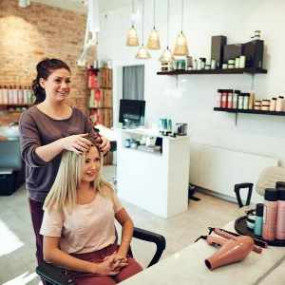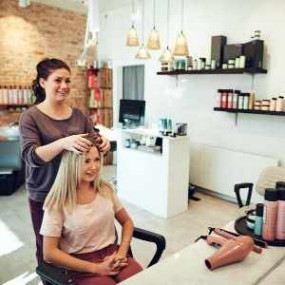ABSTRACT
Tools used in beauty salons can become contaminated with pathogenic microorganisms and can be potential reservoirs of pathogenic microorganisms. This study was aimed at evaluating microbial contamination of beauty salons tools. A total of 30 samples were collected from five (5) hairdressing salons in Umudike, Umuahia metropolis with the aid of moistened sterile swab stick. Each of the diluted samples was inoculated on the media (Nutrient agar, Macconkey agar, Eosin Methylene Blue agar Sabouraud dextrose agar, and Mannitol agar) appropriately with a wire-loop using spread plate method. The plates were incubated at 370 C for 24hrs for bacteria and fungi at 280C for 48hrs -72hrs. The bacterial isolates were identified based on their cultural and biochemical characteristics. A total six (6) bacteria isolates which belonging to the genera of Pseudomonas sp, Bacillus sp, E.coli, Micrococcus luteus, Proteus sp and Serratia marcesens were isolated. A total of four (4) includes Aspergillus niger, Rhodotorula sp, Fusarium oxysorum and Aspergillus flavus were isolated. The percentage occurrence of isolates from user hair brushes and clippers in barbing salons samples shows Pseudomonas sp had the highest occurrence (28.6%) followed by E.coli (21.4%), Micrococcus luteus (21.4%) , Proteus sp (14.3%), while Serratia marcesens (7.14%)and Bacillus sp (7.14%) had the least occurrence. The percentage occurrence of fungi isolates from user hair brushes and combs in beauty salon samples shows Aspergillus niger had the highest percentage occurrence (38.5%) followed by Rhodotorula sp (30.8%) while Fusarium oxysporum (15.4%) and Aspergillus flavus ( 95.4%) showed the lowest occurrence.. The isolation of pathogenic bacteria from hair brushes in this study indicate that hair brushes and hair tools in Hair dressing and beauty Salons could be colonized by pathogenic bacteria and can serve as vehicle of transmission of infectious diseases. Some of these organisms produce very toxic substances that could be very fatal. Hence, it is very important to sanitize the hairbrushes and other hair tools regularly to minimize the spread of these pathogens.
TABLE OF CONTENTS
Title Page i
Certification ii
Dedication iii
Acknowledgements iv
Table of Contents v
Lists of Tables viii
List of Figures ix
Abstract
x
CHAPTER ONE
1.0
Introduction 1
1.1 Aim
and Objectives 2
1.2
Objectives 2
CHAPTER TWO
2.0 Literature Review 3
2.1 Hair Dressing
Tools 3
2.2
Normal Skin Flora 4
2.2.1
Skin Infections 5
2.3 Bacterial Contaminants Associated
With Hair Brushes 7
2.3.1 Staphylococcus aureus 7
2.3.2 Klebsiella species 8
2.3.3 Staphylococcus epidermidis 9
2.3.4
Pseudomonas aeruginosa 10
2.5
Microbial Contamination of Tools Used In Hair Dressing Salons 11
CHAPTER THREE
3.0
Materials And Methods 13
3.1 Sample Collection 13
3.2 Media Used and Preparation 13
3.3
Sterilization 14
3.4 Isolation and Enumeration of
Bacterial Isolates 14
3.5
Identification and Characterization of Bacteria 14
3.6
Isolation and Enumeration of Fungal Isolates 15
3.7
Morphological Characterization of Bacterial Isolates 15
3.7.1
Gram staining 15
3.7.2
Spore Staining Technique 16
3.7.3 Motility Test 16
3.8 Biochemical Identification of
Isolates 16
3.8.1
Catalase test 16
3.8.2
Coagulase Test 17
3.8.3
Citrate Test 17
3.8.4
Indole Test 17
3.8.5 Methyl Red Test 18
3.8.6 Oxidase Test 18
3.8.7 Urease Test 18
3.8.8 Voges-proskaeur Test 19
3.8.9 Sugar Fermentation Test 19
3.9 Characterization and Identification of the
Fungal Isolates. 20
3.9.1 Lactophenol Cotton Blue Staining 20
3.9.2 Slide Culture Test 20
3.10 Statistical Analysis 20
CHAPTER FOUR
4.0 Results 21
CHAPTER
FIVE
5.0 Discussion, Conclusion And Recommendation 35
5.2
Conclusion 37
5.3
Recommendation 37
LIST OF TABLES
Table Title
Page
1 Cultural characteristics
of bacterial isolates 22
2 Biochemical characterization and identification
of isolates 24
3 Identification and
characterize of fungal isolates in user hair brushes 26
and combs in beauty salons
4 Percentage
occurrence of bacterial isolates from
user hair brushes 30
and combs in beauty salons.
5 Percentage
occurrence of fungal isolates from user hair brushes and comb 31
in
beauty salons
CHAPTER ONE
1.0 INTRODUCTION
Besides
the day to day interactions of people which constitute one way of spreading
disease, the major source and spread of infections in communities are fomites
(Kramer et al ., 2006). The environment plays an
important role in transmission of microbial agents to humans, with many
environmental materials serving as vehicles (WHO, 2018). Tools used in Beauty
salons can become contaminated with pathogenic microorganisms and can be
potential reservoirs of such pathogenic microorganisms. Any service with the potential
to break the skin’s surface can be associated with infections, and these
infections can be transmitted to and between clients if proper infection
control procedures are not implemented. Beauty salon services may pose
potential health concerns to their clients, including risk of infection and
injury. These health risks will vary depending on the nature of the service,
the tools used, the health status of the clients and service providers, as well
as the infection control procedures implemented. While invasive procedures,
such as piercing and tattooing, are clearly associated with bacterial and viral
infection risks, even non-invasive procedures, such as hair dressing, pedicure
and manicure can result in infections (Stout et al., 2011).
Beauty
salons play an important role in possible transfer of skin and eye infections
due to the use and reuse of beauty salon tools and equipment (Enemuor et al ., 2013). Items such as razors,
scissors, combs, clippers and hairpins can accidentally pierce the skin. Nail
and cuticle clippers, nail files, and callus removers used in beauty salons
have also been implicated in disease establishment among beauty salon
users (Onajobi et al., 2015).
Beauty
salons are considered high-exposure environments for transmission of human
pathogens . Ruddy et al .(2013)
reported a case of Methicillin-resistant Staphylococcus
aureus (MRSA) infection in patient
previously tested negative for MRSA, after a visit to the hospital hairdresser.
Improperly sanitized cuticle cutters had been attributed to cause varying
serious complications, ranging from an inflamed cuticle to hepatitis (John et al., 2013). Pelenita (2006) stated
that dirty instruments also contribute to infection by blood borne diseases
such as HIV or hepatitis. Other infections that can be spread in hairdressing
premises include skin infections on the scalp, face and neck such as impetigo
and fungal infections such as Tinea
capitis and Tinea barbae (Onajobi
et al.,2015). Commonly isolated
bacteria from hair dressing and beauty salons include Staphylococcus aureus, Staphylococcus
epidermis, Klebsiella pneumoniae,
Pseudomonas aeruginosa, Bacillus spp. Micrrococcus
spp. Enterococus spp. and Enterobacter spp. while fungal isolates
include Aspergillus flavus, Aspergillus
fumigates, Alternaria spp., Cladosporium
spp., Geotrichum candidum, Rhizopus
nigricans., Cladosporium, Trichophyton spp., Mucor spp., Rhizopus
arrhizus, Candida albicans and Penicillium spp. (Onajobi et al., 2015).
1.1 AIM AND OBJECTIVES
The
aim of this study is to evaluate microbial contamination of beauty salons
tools.
1.2 OBJECTIVES
1. To
isolate bacteria and fungi associated with beauty salons tools.
2. To
determine the microbial population and diversity in selected beauty salon tools
3. To
determine the distribution of microorganisms in selected beauty salon tools.
Click “DOWNLOAD NOW” below to get the complete Projects
FOR QUICK HELP CHAT WITH US NOW!
+(234) 0814 780 1594
 Business Plan 120
Business Plan 120
 Case study 0
Case study 0
 Feasibility Study 44
Feasibility Study 44
 Software License 6
Software License 6
 Training Manual 2
Training Manual 2











Login To Comment